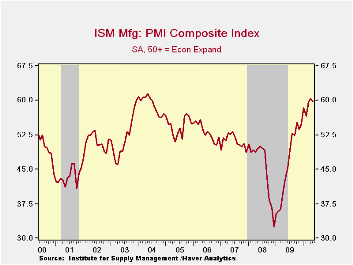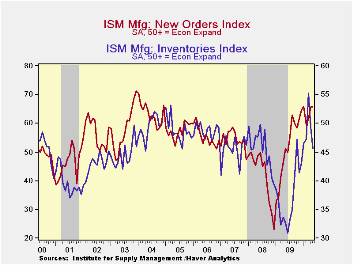 Global| Jun 01 2010
Global| Jun 01 2010U.S. ISM Index Indicates Topping Of Factory Sector Growth
by:Tom Moeller
|in:Economy in Brief
Summary
Rising trends don't have unending momentum. And the current rebound in factory sector activity appears to be no exception. The Institute for Supply Management indicated that their May composite index of factory sector activity slipped [...]


Rising trends don't have unending momentum. And the current rebound in factory sector activity appears to be no exception. The Institute for Supply Management indicated that their May composite index of factory sector activity slipped to 59.7 from 60.4 in April. While May's figure was higher than Consensus expectation's for a decline to 59.0, recent levels have been historically hard to sustain. Still, the latest figure is up from the low of 32.5 reached in December '08. (Any figure above the break-even point of 50 suggests rising activity.) The ISM data is available in Haver's USECON database.
A slower rate of inventory accumulation was the main source of the composite index's May weakness. The new orders, production and vendor performance components were roughly unchanged. Notable, however, was the slight gain in the employment index to 59.8. It was the highest level since early-2004. During the last ten years there has been an 89% correlation between the ISM employment index and the m/m change in factory sector payrolls.
Also showing lift was the separate index of export orders to 62.0 which was the highest level since 1988. During the last ten years there has been an 88% correlation between the level of the index and the quarterly change in merchandise exports. Twenty-eight percent of respondents reported higher export orders while fourteen reported lower orders.
The separate index of prices paid slipped to 77.5 from its high for this recovery. It remained up from the December '08 low of 18.0. Sixty percent of respondents reported higher prices while only 5% indicated lower prices. During the last twenty years there has been an 83% correlation between the price index and the three-month change in the PPI for intermediate goods.
The ISM data are available in Haver's USECON database.
The Policy Response to the Crisis in Korea and Other Emerging Market Economies is Saturday's speech by Fed Chairman Ben S. Bernanke and it can be found here.


| ISM Mfg | May | April | March | May '09 | 2009 | 2008 | 2007 |
|---|---|---|---|---|---|---|---|
| Composite Index | 59.7 | 60.4 | 59.6 | 43.2 | 46.2 | 45.5 | 51.1 |
| New Orders | 65.7 | 65.7 | 61.5 | 51.4 | 51.6 | 42.1 | 54.3 |
| Employment | 59.8 | 58.5 | 55.1 | 35.1 | 40.5 | 43.3 | 50.5 |
| Production | 66.6 | 66.9 | 61.1 | 47.0 | 50.4 | 45.2 | 54.1 |
| Supplier Deliveries | 61.0 | 61.3 | 64.9 | 50.0 | 51.4 | 51.6 | 51.2 |
| Inventories | 45.6 | 49.4 | 55.3 | 32.7 | 37.1 | 45.5 | 45.4 |
| Prices Paid Index (NSA) | 77.5 | 78.0 | 75.0 | 43.5 | 48.3 | 66.5 | 64.6 |
Tom Moeller
AuthorMore in Author Profile »Prior to joining Haver Analytics in 2000, Mr. Moeller worked as the Economist at Chancellor Capital Management from 1985 to 1999. There, he developed comprehensive economic forecasts and interpreted economic data for equity and fixed income portfolio managers. Also at Chancellor, Mr. Moeller worked as an equity analyst and was responsible for researching and rating companies in the economically sensitive automobile and housing industries for investment in Chancellor’s equity portfolio. Prior to joining Chancellor, Mr. Moeller was an Economist at Citibank from 1979 to 1984. He also analyzed pricing behavior in the metals industry for the Council on Wage and Price Stability in Washington, D.C. In 1999, Mr. Moeller received the award for most accurate forecast from the Forecasters' Club of New York. From 1990 to 1992 he was President of the New York Association for Business Economists. Mr. Moeller earned an M.B.A. in Finance from Fordham University, where he graduated in 1987. He holds a Bachelor of Arts in Economics from George Washington University.






